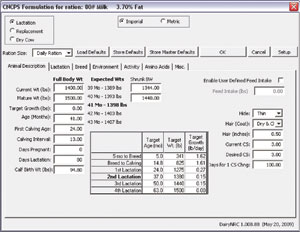The seasons are changing. The mornings are much cooler. Summer fans are quiet. As you walk the alley, heads are down; puffs of moisture come from noses buried deep in fresh feed. The aroma of fresh alfalfa silage and the quiet, satisfied sounds of soft bawls and a few sneezes gives you true satisfaction that your lactating cows are happy. They’re eating. They’re resting. Milk production is good. Life is good.
How do you stay in this happy place?
From calves up, you’ve provided the best nutrition and health care to have well-bred, healthy, productive replacement heifers. After all, a high- performing milking string starts with a solid base of heifers.
As those healthy heifers become lactating cows, ration balancing is a fairly normal practice for developing their rations. You know that ration balancing helps you and your nutritionist get the best use of your feedstuffs and maintain your herd’s production and health.
What about the rations for your dry cows and heifers on the farm? Would ration balancing give you the same cost control and nutrition advantages for those groups?
Where do you start?
Ration balancing, in simple terms, involves making sure that an animal’s nutrient requirements are met on a daily basis. Ration- balancing software generates a list of nutrient requirements and you select feed ingredients to meet those requirements, whether it’s for lactating cows, dry cows or heifers.
Of course, to meet or exceed those nutrient needs, you have to know dry matter intake. Maybe you know the dry matter intake. But it’s also calculated by many record-keeping systems for milking cows and often predicted by ration-balancing software.
So, in order to predict dry matter accurately, even for dry cows or heifers, you must define the animal you’re feeding. You need an accurate estimate of bodyweight, body condition and environmental factors.
Also consider other factors that influence intake and nutrient requirements, like breed, environment, activity and previous level of production.
Grouping cows
Higher-producing cows have different intakes and requirements than lower-producing cows. Heifer intakes will be lower than mature cows. The ability to predict dry matter intake parameters tend to be easiest for lactating cows when we divide them into groups based on age and production.
Don’t have enough cows or heifers to separate into groups? Balance your rations to a desired level of production. Lower-producing cows and heifers will eat less feed than the higher producers, which modifies the nutrient supply. Once a ration is formulated, ration-balancing programs allow “spot checks” to ensure that your predicted changes in dry matter intakes still meet the animals’ nutritional needs.
Dry cow ration balancing
Dry cows have rapidly changing requirements due to the developing fetus. Meeting the nutrient requirements of dry cows helps you avoid metabolic disorders and gives cows a good start to lactation; however, this period is often overlooked as a time when cows can benefit from ration balancing.
Close-up cows have higher nutrient needs than far-off cows. Intakes may decline as cows approach calving. Ration balancing lets you refine the nutritional needs of your transition cows based on their stage of pregnancy.
Heifer ration balancing
Replacement heifers are the future of your dairy herd. Most ration-balancing software allows users to balance rations for heifers. But because heifer requirements can be vastly different depending upon age and pregnancy, this becomes a challenge for many average-sized dairies.
Many producers prefer to have a simpler system to meet the nutritional needs of heifers, such as one or two rations offered at varying rates along with forage. Ration-balancing software can help you develop those feeding scenarios.
Ration balancing advantages
Balancing diets for the full array of cattle on your farm offers economic and nutritional advantages.
- Better control of feed inventories
- Best use of on-farm forages and cost-saving commodities.
- Taking advantage of bargain ingredients without sacrificing production or nutrition
- Allowing better monitoring of your stock by setting performance targets
Although your dairy may not be huge, don’t overlook the opportunity to use ration balancing to improve performance and lower input costs for all animals.
Ration balancing for lactating cows, dry cows and heifers could be your ticket to staying in a “happy place.” PD
 Click the image at left to open at full size in a new window.
Click the image at left to open at full size in a new window.
Defining the animal is as easy as filling in a chart with accurate information. Many software applications provide guidelines to help avoid mistakes. This page provides the animal description.
Note tabs for lactation (milk production), breed, environment and activity – all factors that are important to accurately determine feeding requirements.

-
Essi Evans
- Dairy Nutrition/ Model Adviser
- Dalex Livestock Solutions
- Email Essi Evans







